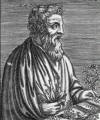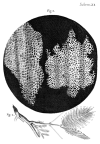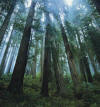Lecture Notes: Set No. 1
INTERNET LINKS TO USEFUL INFORMATION
Biology of Plants and the Study of Botany
The following web page represents a copy of my notes that formed the basis of lectures given during the first portion of the Biology of Plants (BOT 1103) lecture course. Please refer to your own notes, handouts, and to the textbook (Stern, K., R., J. E. Bidlack, and S. H. Jansky. 2008. Introductory Plant Biology, McGraw-Hill. 616 pp. - reading assignments are in the syllabus) for additional information. This web page does not include information found in various handouts and related materials (e.g., films, charts, overhead projections, etc.) that you will receive during the course of the semester. You will be evaluated over this information as well. If you note any errors in the following document, I'd appreciate it if you would bring this to my attention. Email address: mhuss@astate.edu.
Introduction to Course - Day 1
- Instructor of Record: Dr. Martin Huss.
- Handed out syllabus/course policy to students.
- Reviewed course policy, emphasis on grade evaluation, examination format, testing dates, make-up policy, etc.
- Reviewed general information found in syllabus (e.g., reading assignments, office phone number, office hours, etc.).
How to be successful in this botany course!
- Read book (reading assignments listed in the syllabus), exams will cover both lecture and reading assignments.
- Beginning of chapters have an outline and a chapter overview: review these!
- Bold-faced headings and terms - know these terms or concepts.
- Read chapter summaries.
- Review Questions - some test and quiz questions will be based on review questions at the end of the chapter.
- Look at diagrams and figures given in each chapter that is covered.
- Re-write your lecture notes the same day these are given.
- Cross-reference your notes with the ones posted on the internet.
- Ask questions!!!
- The Department of Biological Sciences also offers free tutoring for students who are enrolled in this and other 1000 to 2000 level undergraduate biology courses. Contact LSE 202 for more information.
Lecture and Topic Outline
- Plants - common examples (e.g., duckweed, redwood tree, etc.) and biodiversity.
- Characteristics of Plants.
- Role of plants in the biosphere.
- Beneficial Effects of Plants
- Brief history of botany.
- Botany or Plant Biology and the Nature of Science.
- Activities associated with plant life and life in general.
I. Plants - Common examples and biodiversity
Name a plant! (Duckweed, geranium, apple tree, oak tree, dandelion, algae, redwood tree, carrot, etc.). Lots of biodiversity! Plants come in different shapes, sizes. Some are short-lived, others live for hundreds of years. Plants have adapted to a wide variety of habitats, and methods of reproducing and dispersing themselves.
According to E. O. Wilson in his book, "The Diversity of Life" there are about 248,400 species of higher plants (i.e., ferns, gymnosperms, bryophytes, flowering plants). There are about 26,900 species of algae.
TAKE HOME MESSAGE - Many species; biodiversity is high!
II. Characteristics of Plants
-
Autotrophs - obtain energy/building materials by process known as photosynthesis.
-
Sedentary (Plants don't move about).
-
Modular construction - repeating units due to localized areas of growth (meristems); plants grow at their tips and outward in girth.
-
Different modules perform specific functions
-
Roots - anchorage and absorption of water and dissolved nutrients.
-
Leaves - absorption of light energy and atmospheric gases (carbon dioxide).
-
Reproductive structures; male, female, or both sexes (e.g., flowers, cones).
-
Structures that hold spores or seeds as they mature (e.g., sporangia, cones, fruits).
-
Stem - support leaves and reproductive structures, and the link between these modules and the root system.
-
-
Upper/lower surfaces of plants are highly branched. Maximize surface area for absorption of gas, light, nutrients and water.
-
Cellular level (i.e., eukaryotes/multicellular, chloroplasts, cell walls, and large vacuoles).
III. Role of plants in the biosphere

Energy flow from sun to producers; yellow
arrow = sunlight. Energy and material flow from producers
to other organisms; green arrows; material
flow from environment = gray arrow
(e.g., carbon dioxide, water, and nutrients); material flow from consumers
and decomposers back to producers = red arrow
(e.g., carbon dioxide, water, and nutrients). Of the three (producers,
decomposers, and consumers), which two are essential to life on earth?
(Answer: producers and decomposers). Least significant are
the consumers, although these can be important ecologically for specific
plants (e.g., pollination and seed dispersal).
IV. Beneficial Effects of Plants
1. Food
2. Resupply oxygen to
atmosphere (11 year supply on earth).
3. Maintain the climate
(deforestation is of concern).
CONSIDER DOING THIS: Make a list of plants and plant products that you have come in contact over the course of a single day. List the plant and how it was used by yourself. List a particular usage only once. For example, don't list tomato if you eat the fruit in a salad or on a hamburger twice. But if you eat ketchup then list it again. How does this list relate to the quality of your everyday life?
What kinds of plants/plant products have you come in contact with today? Examples: Food, medicine, spices, fibers, paper, clothing, lumber, oxygen, fuel (coal and wood), toothpicks, toilet paper, paper money, soft drinks, drugs, and so on.
TAKE
HOME MESSAGE - Plants are necessary for our continued existence and quality
of life.
V. Brief history of botany.
Early human cultures were hunter/gatherers. One of the first professions was botany (plant taxonomy), because it was important knowledge to be able and distinguish poisonous from edible plants.
About 8,000 -12,000 years ago something happened that changed the heart of human society. What was it? Answer: Agriculture!
Agriculture - fossilized plant remains (e.g., seeds, charred plant remains, pollen) in archaeological digs of human encampments place the discovery of agriculture about 8,000 to 12,000 years ago.
Most ancient civilizations (e.g., Chinese, Egyptians, Assyrian, Inca, Mayan, etc.) practiced agriculture regardless of their geographical location in the world. Indigenous plants (and animals) were domesticated by each respective society.
Two hypotheses about origin of agriculture:
1. Independent discovery in
different parts of world.
2. Diffusionist hypothesis
- discovery originated in one part of the world and spread from
one civilization
to another.
Plants for food/medicine:
In preliterate societies, knowledge of what was good or bad was passed on in oral traditions, usually through religious leaders - the 'medicine man' or shaman among certain North American Indians and their counterparts in other societies (e.g. priests, rabbis, teachers).
In literate societies, this information was transmitted by means of the written word. Early
examples include:
- plant taxonomy and biogeography
- plant physiology
- plant ecology
- plant morphology, anatomy, and developmental biology
- plant cytology (cell structure and function)
- plant genetics
- ethnobotany and economic botany
- genetic engineering - for crop improvement, insect repulsion, soil reclamation, longer shelf-life of fruits, disease resistance, etc...
TAKE-HOME MESSAGE:
The field of botany is a culmination of many historical events and consists
of many different scientific disciplines.
VI. Botany or Plant Biology and the Nature of Science.
WHAT IS SCIENCE?
Science is an organized system of knowledgea obtained by a special methodb, the "scientific method", of research and aimed at explaining the causes and behavior of the natural universec.
aThere are different kinds of knowledgea: e.g., knowledge of a language, literature, automotive mechanics, cooking, law, philosophy, the meaning of words.
bSCIENTIFIC METHOD
Science is not about proof or absolute truth. Science is more about reducing uncertainty then stating things as hard cold fact.
1. Problem or question based on
observation.
2. Hypothesis - "education guess" to answer
or explain the question.
3. Experimentation (to determine if the
hypothesis is valid or not).
A. Prediction
B. The test
4. Conclusion
cNatural universe - Science can say how a guitar string creates sound when plucked, but it can say little about the aesthetic value of music. Science can say nothing outside it's realm of expertise, in regard to ethics, morality, and the supernatural.
When scientists engage in scientific research, most of them don't sit down and think, "Gee, I think I'll make an observation. What kinds of questions come to mind? Perhaps I should write down some potential hypotheses. 1,2,3, 4 etc. Ah, now let's see, I will do an experiment to test one of my hypotheses. I will engage in inductive and deductive reasoning". Scientists don't act like the stereotypic characters on television shows (e.g., Mr. Spock from Star Trek or the Professor from Gilligan's Island). Creativity, personal biases, hard work, hit and miss speculation, experimentation, availability of funds and resources, existence of appropriate technology, and dumb luck all come into play. The reason for outlining the "scientific method" is to try to dissect the essential elements of the process. Also scientists aren't like Bill Nye - the science guy, Mr. Wizard, or Beakman from Beakman's World. These are science educators, but when they do experiments they already know what the outcome of the experiment will be. Not so with scientists.HYPOTHESIS: a proposed explanation of certain "facts" that must be empirically testable in some conceivable fashion.
THEORY: an integrated, comprehensive explanation of many "facts" and an explanation capable of generation additional hypotheses and testable predictions about the way the natural world looks and works. A generally accepted scientific theory is a well-tested hypothesis supported by a great deal of evidence. The scientific definition of theory is different then what is used by the lay person - like a guess. "Oh well, it's only a theory". In fact a theory is well tested, and if consistent with the data, possesses a high degree of certainty (although not equivalent to proof).
Something Fun to Think About: Chaos, Fractals in Nature (including Plants), and the Nature of the Universe at http://video.yahoo.com/video/play?ei=UTF-8&gid=1510687&vid=1053871&b=2 or http://www.rocketboom.com/vlog/rb_07_aug_31b.
VII. Activities associated with plant life (and life in general).
In your mind consider the question of which of the following objects you would consider to be alive and not alive. At beginning of this section, ask the class which of the following objects is alive. A frog, a stone, a virus, a seed, and a tree.
What did you base your answer on? Most people have an intuitive feel or sense for determining what is alive or not alive. But coming up with a precise definition is difficult. In 1994, a conference of scientists argued whether or not viruses, which appear to have properties of both being living and nonliving were alive or not. One scientist, by the name of Stephen Hawking has publicly argued that not only are biological viruses alive, but that computer viruses constitute an artificial life form.
Living organisms share certain characteristics or activities that separate them from non-living matter. What are some of these?
- Structure/organization, which arise from the basic properties of matter and energy.
- Metabolism - "energy transfers".
- Homeostasis - Maintain a livable internal environment.
- Reproduction
- Response to stimuli (e.g., temperature, injury, light, gravity, etc.).
- Movement.
- Mutations or changes in form are possible.
- Adaptation to the environment.
- Interdependence among organisms (no tree is an island unto itself!).
- Blueprint of life is coded by DNA.
- Growth.
Lecture and Topic Outline
- Discovery of plant cells and the microscope.
- Components of the plant cell.
- Mitosis and cytokinesis.
I. Discovery of plant cells, the microscope and cell theory.
In 1665, Robert Hooke using a crude light microscope saw and described cells in a piece of cork. This is a good example of how certain discoveries are dependent on the development of appropriate technology. The discovery of cells was dependent on the development of the light microscope. Can you think of any other examples where this is true? [Laboratory equipment and procedures (e.g., refrigeration, electrophoresis, ultracentrifugation, etc.) required for many types of scientific study would not be possible without a grasp of basic technology, such as, the production and use of electricity, which has only been around for about one century; Detailed discoveries about our solar system were dependent on development of rocket propulsion systems, computers, educated and technologically sophisticated support personnel, etc.].
Three ways to make visual observations:
II. Components of the plant cell.
Parts of the plant cell
-
Cell wall - cellulose forms micro- and macrofibrils which are held together by pectin and related substances.
-
primary cell wall - cellulose, hemicellulose, and pectin.
-
secondary cell wall - inside primary cell wall, cellulose, hemicellulose, and lignin (complex alcohol polymer).
-
plasmodesma (singular), plasmodesmata (plural) - holes in the wall that act as channels for protoplasm movement between cells middle lamella - pectin.
-
Plant cell shape - keep in mind that not all plant cells are box-shaped - for example, the epidermal cells of geranium leaf are shaped and arranged like pieces of a jig-saw puzzle.
-
Plasma membrane is semi-permeable (channel and carrier proteins are responsible for active and passive transport. Phospholipid bilayer membrane - follows 'fluid mosaic model of cell membrane structure'.
-
Cytoplasm or protoplasm - fluid matrix that organelles are embedded in, largely made of water and dissolved substances (proteins, sugars, salts, etc...). Also contains the cytoskeleton (network of protein fibers) that help to anchor organelles and help give the cell its shape.
-
Nucleus - chromatin or chromosomes (DNA and protein) + nucleolus (nucleolus organizer region - NOR on some chromosomes) which produces rRNA which is found complexed with protein in the ribosomes (protein synthesis). Bound by membrane - nuclear envelope which contains pores.
-
Endoplasmic reticulum - rough (with ribosomes) and smooth (without ribosomes) - channels of membranes involved as site of protein and lipid synthesis and movement of protein products.
-
Golgi apparatus or body = Dictyosomes - storage of proteins, lipids, and carbohydrates.
-
Flagella and Cilia are made up of microtubules in a 9 + 2 arrangement - movement.
-
Lysosomes and peroxiosome - membranebound vesicles which contain enzymes for the breakdown of organic compounds (the latter uses oxygen and produces hydrogen peroxide).
-
Mitochondrion - power house of the cell - aerobic respiration.
-
Plastids (e.g., chloroplasts - associated with photosynthesis, leucoplasts - starch amyloplasts) or oil storage (elaioplasts), chromoplasts - carotenoid-containing).
-
Large vacuoles - bounded by a membrane, the tonoplast, and often containing crystals and soluble pigments, such as anthocyanin, in the cell sap.
-
Plant cells lack centrioles, which occur in pairs, composed of microtubules.



III.
Cell Division: Mitosis and cytokinesis
INTERPHASE is composed of G1, S, and the G2 phase. The cell cycle follows: G1 (gap 1 - interval before DNA replication and protein synthesis) ===> S (synthesis - replication of DNA and protein synthesis) ===> G2 (gap 2 - interval before onset of mitosis) ===> MITOSIS + CYTOKINESIS===> G1 ......
- Prior to and after mitosis (i.e., during interphase), the material in the nucleus (chromatin) is uncondensed.
- Chromatin is made of about 60 % protein and 40 nucleic acid.
- Chromatin = uncondensed chromosomes.
-
Chromosome size, morphology, and number
various from one species to the next:
- Broad bean - Vicia faba (haploid, n=6; diploid, 2n=12)
- Corn - Zea mays (haploid, n=10; diploid, 2n=20)
- Cotton - Gossypium hirsutum (haploid, n=26; diploid, 2n=52)
- Evening primrose - Oenothera biennis (haploid, n=7; diploid, 2n=14)
- Garden onion - Allium cepa (haploid, n=8; diploid, 2n=16)
- Garden pea - Pisum sativum (haploid, n=7; diploid, 2n=14)
- Green alga - Chlamydomonas reinhardi (haploid, n=16; diploid, 2n=32)
- Jimson weed - Datura stramonium (haploid, n=12; diploid, 2n=24)
- Snapdragon - Antirrhinum majus (haploid, n=8; diploid, 2n=16)
- Tobacco - Nicotiana tabacum (haploid, n=24; diploid, 2n=48)
- Tomato - Lycopersicon esculentum (haploid, n=12; diploid, 2n=24)
- Water lily - Nymphaea alba (haploid, n=80; diploid, 2n=160)
- Wheat - Triticum aestivum (haploid, n=21; diploid, 2n=42)
Unduplicated chromosomes vs. duplicated chromosomes.

MITOSIS - nuclear division
-
Prophase - chromosomes begin to condense/nuclear membrane breaks down, nucleolus disappears.
-
Movement is coordinated by organized arrays of microtubules called the spindle apparatus.
-
In animals and fungi these fibers radiate from centrioles - plant cells do not produce centrioles, although the spindle apparatus still forms.
-
Metaphase - chromosomes move to the center or equator of the cell.
-
Anaphase - sister chromatids are pulled apart toward the poles.
-
Telophase - chromosomes decondense, nucleoli reform, nuclear membrane reforms, spindle fibers disappears, cell plate forms.
 For
some very helpful information visit the following Web Site:
Biology I Animations,
Movies & Interactive Tutorial Links. Visit the categories: Cell Structure
& Function, Cell Transport, and Mitosis/Meiosis. You may find it quite
informative, though some links are better than others.
For
some very helpful information visit the following Web Site:
Biology I Animations,
Movies & Interactive Tutorial Links. Visit the categories: Cell Structure
& Function, Cell Transport, and Mitosis/Meiosis. You may find it quite
informative, though some links are better than others.
Lecture and Topic Outline
- Types of tissues.
- Meristematic tissues.
- Simple tissues.
- Complex tissues.
I. TYPES OF TISSUES
Plant cells form the basis for plant tissues (i.e., meristematic, simple, or complex), which in turn form the basis for various organs (e.g., leaves, roots, reproductive organs, etc.). Tissue patterns in roots and stems vary among woody dicots, herbaceous dicots, and monocots.
II. MERISTEMATIC TISSUES
Apical meristems are responsible for primary growth. Vascular and cork cambium is responsible for secondary growth. Secondary growth is not common to all plants, predominates in woody species.
- Apical meristems==> gives rise to 3 types of primary or transitional meristems ==> protoderm (becomes epidermis), ground meristem (becomes cortex and pith, or ground tissue), and procambium (becomes vascular tissue). Primary growth occur at the tips of shoots and roots.
- Lateral meristems ==> secondary growth
- vascular cambium, increases girth of stem, replaces dead phloem and xylem.
- cork cambium = phellogen ==> cork and parenchyma cells to replace the damaged epidermis ==> periderm.
- Intercalary nodes (grasses - growth at the base of nodes, responsible for stem elongation; allows grass to replace its growth after fires, herbivory, and mowing.
-
Parenchyma - found in roots, stems and leaves, undifferentiated thin-walled, large vacuoles, often contain secreted material (starch, oils, tannins, crystals).
-
Aerenchyma - parenchyma tissue with extensive intercellular air spaces (e.g., water lilies and spongy mesophyll of leaves).
-
Chlorenchyma - parenchyma with numerous chloroplasts (common in leaves).
-
Collenchyma - thick-walled but flexible and strong, usually right below the epidermis of a leaf or stem, used for support in stems and leaves of non-woody or young plants.
-
Sclerenchyma - thick walls impregnated with lignin, usually dead at maturity, function is support.
-
Sclerids - stone cells in pear, hard part of seeds and nutshells (cells are long as they are wide).
-
Fibers - much longer in length than they are wide, fibers are used in rope, textiles, canvas, paper money (common sources are hemp, cotton, and flax).
-
-
Epidermis - outermost layer of cells covering a plant. Functions for purposes of absorption (carbon dioxide and water) and protection (from water loss and pests). Usually one-celled thick, although some plants have a multicellular epidermis (orchids have velamen roots to prevent water loss). The epidermis is covered by a fatty substance called cutin (the cuticle) to prevent dehydration and enhance pest resistance. Openings in surface of epidermis are called stomata (pl.) or stoma (sing.). Opening created by two guard cells which are sausage (dicots) or bone shaped (monocots). Only the guard cells in the epidermis possess chloroplasts.
-
Trichome- epidermal outgrowths. Examples include, glands on leaves (mint, geranium, marijuana (tetrahydrocannabinols - THC), protective hairs of stinging nettle, trichome fibers on seeds of cotton (95 % cellulose).
-
In roots, tubular extensions arise from epidermis (root hairs). Greatly increases the surface area for absorption of water by several thousand fold.
-
Complex tissue - made of more than type of cell. Three types include the xylem (vascular tissue), phloem (vascular tissue), the periderm (part of the bark of woody plants - cork and parenchyma cells) and secretory structures.
XYLEM
-
transports water and dissolved substances (nutrients).
-
This tissue is composed of parenchyma, fibers, vessels and/or tracheids, and ray cells.
-
Vertical movement of water and dissolved mineral nutrients
-
vessels - are made up of vessel elements joined end to end like a series of drinking straws. Dead at maturity.
-
tracheids - possess tapered unopened ends. Dead at maturity.
-
Horizontal movement of water and dissolved mineral nutrients through ray cells - horizontal rows of long-lived parenchyma cells produced by ray initials in the vascular
-
Secondary xylem is produced by the vascular cambium.
-
Cone-bearing trees contain mostly tracheids, while flowering trees contain vessels/tracheids.

SIMPLE
PITS

BORDERED
PITS

PHLOEM
- Phloem is involved in the conduction of dissolved food, sieve-tube members (no nucleus at maturity, cytoplasm present), companion cells, fibers, parenchyma, and ray cells. Sieve-tube members and companion cells arise from the same cell. Found in flowering plants.
- Sieve cells occur in non-flowering plants associated with albuminous cells (parenchyma cell) which are not derived from the same cell. Albuminous cells regulate activities of sieve cells.

PERIDERM
- In woody plants the epidermis is sloughed off by periderm from the cork cambium.
- Cork cells are dead at maturity, cell walls contain a fatty substance called suberin.
- Lenticels - open surfaces in bark that arise from periderm, loosely packed parenchyma cells. Lenticels are involved in gas exchange.
- nectar (flowers) from nectaries
- oils (peanuts, oranges, citrus) from accumulation of glands and elaioplasts.
- resins (conifers) from resin canals
- lacticifers (e.g., latex - milkweed, rubber plants, opium poppy)
- hydathodes (openings for secretion of water)
- digestive glands of carnivorous plants (enzymes)
- salt glands that shed salt (especial in plants adapted to environments laden with salt).
VISIT http://botit.botany.wisc.edu/images/130/ FOR IMAGES OF PLANT CELLS AND TISSUES: CLICK ONTO LINKS LISTED AS CELLS AND TISSUES; MITOSIS; AND PLANT CELL.
This page is maintained by Dr. Martin Huss. Last modified September 6, 2007.

















